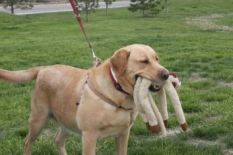
Obesity in Dogs
 Dogs are master manipulators... those pleading eyes or a cutely raised paw can quickly convince pet owners
to give their pets a "little treat". Unfortunately, those little treats begin to add up - and too
many calories can lead to fat dogs. Obesity in dogs isn't about how
a dog looks; the extra weight can lead to serious health issues as well as prevent dogs from enjoying life
to the fullest.
Dogs are master manipulators... those pleading eyes or a cutely raised paw can quickly convince pet owners
to give their pets a "little treat". Unfortunately, those little treats begin to add up - and too
many calories can lead to fat dogs. Obesity in dogs isn't about how
a dog looks; the extra weight can lead to serious health issues as well as prevent dogs from enjoying life
to the fullest.
Problems Pets Can Face With Obesity
There's a myth that spaying or neutering your dog makes it fat. This is just an excuse. There are many spayed and neutered pets who are in good body condition. The key is providing your pet with adequate exercise and the appropriate number of calories.
Why bother to go through the hassle of keeping your dog in sleek shape? What's wrong with a few extra pounds? Aside from missing out on the fun of an active dog life (rolling in the grass, romping through the woods, frolicking with other canine friends, etc), obesity can lead to:
- Joint problems - the extra weight puts more demand on joints that weren't meant to handle it.
- Extra stress on heart and on lungs, which need to work harder.
- Breathing problems.
- Greater susceptibility to injuries.
- Heat intolerance.
- Increased health risks such as canine diabetes.
Maintaining a Healthy Weight
Sometimes a pet's weight issues may actually be due to medical reasons. In these cases your veterinarian will be able to advise you best on how to keep your pet as healthy as possible. Much more often, though, otherwise healthy dogs are overweight due to consuming too many calories and/or not getting enough exercise.
Here are a few ways you can help your dog maintain a healthy body weight:
Feeding Guidelines Are Only a Suggestion
Use the guides on the back of food packages only as a starting point. You will need to find the right amount to feed your dog so that he keeps a healthy weight, which may differ from what's stated on the package.
Measure your pet's food
It's easy to feed too much when you're just 'eye-balling' the portion. Use a measuring cup to ensure you're not overfeeding. If you want to keep the 'people' measuring cups separate from the 'pets', buy a pet food scoopDon't "Free Feed"
That is, don't leave food accessible all the time. Many dogs will overeat just because it's available. Feed your dog at set meal-times only. If he doesn't eat during that time, then remove the food until the next regular meal-time.
Treats Count
Take into account the number of treat(s) you offer your dog. If your dog gets more than the usual treats one day, cut back on the amount you feed him for his next meal.
Treats From Friends Count, Too
Ask guests or other pet owners you meet at the park not to give your dog treatsExercise
Provided your vet says that your dog is in appropriate health, then exercise your dog regularly. It will help to keep your dog's joints lubricated and healthy, and maintain his muscles (note: putting your dog in the yard by himself isn't "exercise"!). Regular exercise is best, rather than the occasional strenuous hike or play time. Exercising your dog will also give you the opportunity to bond with your pet. And it's fun! Watching a dog bounding joyfully down a trail or rolling ecstatically in the grass is a great stress reliever.
Regular exercise and appropriate nutrition will help your four-legged pal to lead a long, healthy, and happy life.


